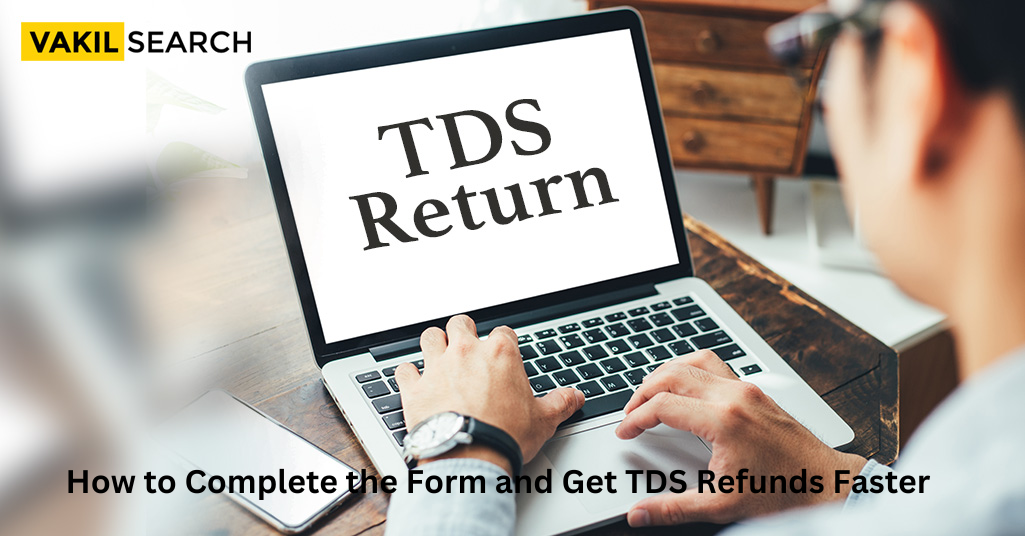Know all the details about TDS refund right away, and also follow all the instructions on how you can apply for the same
Overview:
A TDS refunds are generated when the amount of tax withheld is more than the taxpayer’s actual tax burden. It is common practice to discover, at the end of a given fiscal year, that the projections regarding investments made at the beginning of that year do not correspond with the actual assets made throughout that year.
TDS refunds are issued when there is a disparity between the amount of tax deducted in its entirety after a fiscal year and the amount of income tax expected to be paid for that particular year.
What is a TDS Refund?
TDS refund is the process of claiming the excess tax deducted at source by the payer. For example, if the TDS deducted from your salary is Rs. 30,000, but your actual tax liability is only Rs. 20,000, then you are eligible for a TDS refund of Rs. 10,000. The TDS refund can be claimed by filing an income tax return (ITR) with the Income Tax Department.
TDS Refund Period
The TDS refund period is the time taken by the Income Tax Department to process and refund the excess TDS deducted. The TDS refund period varies depending on various factors such as the amount of refund, the mode of refund, the accuracy of the information provided, etc. Generally, the TDS refund period is around 3 to 6 months from the end of the financial year in which the TDS was deducted.
Instructions On How To Apply For Your TDS Refund:
If you follow the processes that are listed below, you will be able to get your TDS refund:
- Step 1: Step one is to File Your Income Tax Returns if your employer has withheld an amount from your paycheck greater than your actual tax liability under the TDS heading.
- Step 2: In the second step, you will need to provide the essential information, including your bank’s name, bank account number, and IFSC code.
- Step 3: After the tax return mentioning the TDS refund has been submitted, it typically takes a few months for the income tax officer to process the returns and authorise the refund.
TDS Refund for Different Payments
TDS refund can be claimed for various payments such as salary, rent, interest, commission, etc. Let’s understand the TDS refund process for different payments:
TDS refund for salary: If the TDS deducted on your salary is more than your actual tax liability, then you can claim the TDS refund by filing the ITR. The TDS refund will be processed by the Income Tax Department after verifying the details provided in the ITR.
TDS refund for rent: If the TDS deducted on the rent paid to you is more than your actual tax liability, then you can claim the TDS refund by filing the ITR. You need to provide the details of the rent received and TDS deducted in the ITR.
TDS refund for interest: If the TDS deducted on the interest earned by you is more than your actual tax liability, then you can claim the TDS refund by filing the ITR. You need to provide the details of the interest earned and TDS deducted in the ITR.
TDS refund for commission: If the TDS deducted on the commission received by you is more than your actual tax liability, then you can claim the TDS refund by filing the ITR. You need to provide the details of the commission received and TDS deducted in the ITR.
How to Claim TDS Refund Online?
You can claim the TDS refund online by filing the ITR on the Income Tax Department’s website. Follow the steps below to claim the TDS refund online:
- Visit the Income Tax Department’s website – www.incometaxindiaefiling.gov.in
- Login to your account using your PAN and password
- Click on the ‘e-File’ option from the dashboard and select ‘Income Tax Return’ from the drop-down menu
- Select the relevant assessment year and ITR form
- Fill in the details of your income, deductions, and TDS
- Verify the details and click on the ‘Submit’ button
- After submitting the ITR, download the acknowledgment and keep it for future reference
How to Check TDS Refund Status?
You can check the TDS refund status online on the Income Tax Department’s website. Follow the steps below to check the TDS refund status:
- Visit the Income Tax Department’s website – www.incometaxindiaefiling.gov.in
- Login to your account using your PAN and password
- Click on the ‘View Returns/Forms’ option from the dashboard
- Select the relevant assessment year and click on the acknowledgment number of the ITR for which you have claimed the TDS refund
- The TDS refund status will be displayed on the screen
Interest on TDS Refund
If the TDS refund is not processed within the TDS refund period, then the taxpayer is eligible for interest on the TDS refund. The interest is calculated at the rate of 0.5% per month or part of the month from the end of the TDS refund period to the date of actual refund. The interest amount is automatically credited to the taxpayer’s bank account along with the TDS refund.
How to File a Complaint for a Delay in Income Tax or TDS Refund?
If there is a delay in processing the income tax or TDS refund, then you can file a complaint with the Income Tax Department. Follow the steps below to file a complaint:
- Visit the Income Tax Department’s website – www.incometaxindia.gov.in
- Click on the ‘Contact Us’ option from the menu bar and select ‘Feedback/Complaints’
- Fill in the details of your complaint and submit it
- You will receive a complaint number which can be used to track the status of your complaint
Different TDS Refund Statuses
When it comes to your income tax refund, understanding the status codes and the necessary actions to take is vital. Here’s a breakdown of various refund statuses and the actions associated with each:
- Refund Paid:
- Meaning: Your filed Income Tax Return (ITR) has been processed successfully, and the refund has been credited to your account.
- Action: Verify the refund received in your bank account. If you haven’t received the refund, contact your registered bank to resolve any issues.
- No Refund Since There Was No Demand:
- Meaning: Your tax liability is zero, and you are not eligible for any refunds.
- Action: If you have claimed a refund but received this status, review your ITR and the comparison received from the IT Department. If there are discrepancies, file a corrected return if necessary.
- Refund Unpaid:
- Meaning: The IT department has approved the refund, but it couldn’t be paid due to incorrect bank or address details.
- Action: Raise a refund reissue request on the income tax portal and ensure your bank and address details are accurate.
- Undetermined Refund Status:
- Meaning: Your ITR has not yet been processed.
- Action: Wait for a few days and recheck the status later.
- Refund Determined and Forwarded to the Refund Banker:
- Meaning: The IT Department has approved the refund, and the refund banker has been notified.
- Action: Wait for the refund to be credited to your bank account. If necessary, you can contact the refund banker for updates.
- Demand Determined:
- Meaning: Additional tax payment is required due to discrepancies between your tax calculation and the IT department’s calculation.
- Action: Verify the tax calculation under section 143(1). If there’s an error, rectify it by paying the outstanding tax within the specified timeframe. If you believe the IT
- Department’s calculation is incorrect, file a rectification with supporting information.
- Correction Made, Reimbursement Calculated, and Information Submitted to Refund Banker:
- Meaning: Your corrected return has been accepted, and the refund amount has been recalculated and sent to the bank for processing.
- Action: Confirm the refund receipt by checking your bank account.
- Rectification Processed and Demand Determined:
- Meaning: Your rectified return has been accepted, but unpaid tax obligations (demands) have been identified.
- Action: Cross-check all information within the specified time frame and pay the outstanding tax demands.
- Rectification Processed, No Demand and No Refund:
- Meaning: The income tax department has accepted your corrected return, and there are no tax demands or refunds owed.
- Action: No further action is required.
Increase The Rate At Which Tax Refunds Are Processed:
While preparing their annual income tax return, taxpayers should keep the following tips in mind, as doing so can facilitate the quicker processing of tax refunds.
Being Conscientious In The Process Of Preparing The Tax Return
The government offers pre-filled income tax returns (ITRs), on which all relevant information, including salary and interest earned on fixed deposits or NRO savings bank details, is reflected. As a result, it is essential to ensure that none of these is overlooked by accident. It is also helpful to go back and look at the credits on the bank statements to ensure that nothing was missed. Inconsistencies may cause the CPC to send out notifications, necessitating proper online responses and delaying refund processing.
Credit For The Refund Must Be Sought And Applied To A Functioning Bank Account
The Income Tax Return (ITR) form can request credit to numerous bank accounts should a refund be issued. After the return has been processed, the CPC will decide which accounts the refund should be credited to. It is strongly recommended that just one bank account be chosen to credit refunds. In addition, you need to check to ensure that this bank account is still in use.
Verify Your Bank Account, So Your Refund Can Be Deposited Directly Into It
The Income Tax Department had stated that beginning in March 2019, only electronic refunds will be granted, which is a change from previous years when refunds of more than 50,000 rupees were issued in the form of a cheque. Your bank account will need to be pre-validated to proceed, and you can do so by following the steps listed below:
- Obtain a login and password for the “e-Filing” Portal.
- Go to your profile settings and make sure your bank account is pre-validated.
- The pre-validation form will be shown if there is no existing account.
- Enter the “Bank Account Number,” the “Account Type,” the “IFSC,” the “Mobile # Number,” and the “email id,” then click the “Pre-validate” button. (Providing your email address is voluntary; if you do so, it will be verified with the bank)
- The email address associated with the e-Filing account will get an update regarding the request’s status.
In situations in which a tax refund is anticipated, it is critical to make sure that the pre-validation process is finished in its entirety.
Make The Switch To Electronic Verification Of The ITR
After the tax return has been electronically filed, the taxpayer has a period of 120 days during which they can deliver a signed physical copy of the ITRV to the CPC. This allows for sufficient time for the verification process. This also means that the CPC will wait to process the tax return until the verification has been completed. E-verification may be implemented using any of the following choices to facilitate the processing of tax returns in a more practical manner:
# Aadhaar OTP
# Entering the Electronic Verification Code after logging in to e-filing through Net Banking; having a pre-validated bank account and Demat Account data.
# Digital Signature Certificate
Check For Possible Refunds By Logging Into The Online Tax System:
You will get an email with an intimation under section 143(1) once the tax department has finished processing the submitted ITR: https://www.incometax.gov.in/iec/foportal/. A warning will be sent to the taxpayer if the department needs additional information or your case is taken up for tax auditing. It is crucial to check these out and the refund status, which one can do by signing on to the website for income tax e-filing and clicking on the Refund/Demand Status button located under the ‘My Account section of the menu bar.
To check the status of your refund, all you need is your Identification Number (PAN) and the assessment year.
FAQs
How can I refund my TDS online?
You can claim your TDS refund online by filing your income tax return (ITR) and providing your bank account details for direct deposit of the refund amount. You can file your ITR online through the e-filing portal of the Income Tax Department.
When can I claim a TDS refund?
You can claim a TDS refund after filing your income tax return and verifying it. The refund will be processed by the Income Tax Department after verifying your return and the TDS details provided by the deductor.
Is TDS refundable on salary?
Yes, TDS is refundable on salary if the tax deducted from your salary is more than your actual tax liability for the year. You can claim the excess TDS as a refund while filing your income tax return.
How can I check my TDS balance?
You can check your TDS balance by logging in to the TRACES portal of the Income Tax Department using your PAN and password. The portal will show you the details of the TDS deducted and deposited against your PAN.
Will I get a TDS refund even if I have not provided my bank account details in the TDS Certificate or ITR?
No, you will not get a TDS refund if you have not provided your bank account details in the TDS Certificate or ITR.
Is there an option to change contact details from what I provided in the ITR?
Yes, you can change your contact details such as email address and mobile number by logging in to the e-filing portal of the Income Tax Department and updating your profile.
How many different kinds of TDS refund statuses are there in the e-filing portal?
There are eight different kinds of TDS refund statuses in the e-filing portal of the Income Tax Department.
How do I change my address so that I don't miss the refund cheque?
To change your address, you need to update it by submitting a request for correction by logging into http://incometaxindiaefiling.gov.in.
Conclusion
Looking forward to getting more clarification on TDS? If yes, then Vakilsearch is your best bet. The professionals have years of experience in the same domain.
Helpful Links:
- Time Period for TDS Refund
- Complete details about Interest on Late Payment of TDS
- How much is the TDS Payment for Property Purchase?
- How to make TDS Online Payment?
- Filing TDS Online – Documents Required
- Online TDS Filing for Property Sales
- Definition of TDS under section 194J










